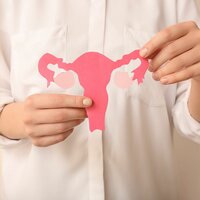There are no products in your shopping cart yet.
Estrogen Dominance and Estrogen Deficiency

Estrogen is one of the most important hormones in the female body, playing a crucial role in the development and regulation of the reproductive system and secondary sexual characteristics (such as breasts, hips, and pubic hair). Over the years, many women experience estrogen dominance. So how is it that when you're in perimenopause or menopause, you also experience an estrogen deficiency?
How can you have both estrogen dominance and an estrogen deficiency at the same time?
It may seem contradictory, but it is possible to have both estrogen dominance and an estrogen deficiency simultaneously. This is due to the complex interactions between different hormones in your body. Let’s take a closer look to understand how they can occur together.
What is Estrogen Dominance?
Estrogen dominance occurs when the balance between the hormones estrogen and progesterone is disrupted. This means that even if the amount of estrogen in your body is normal or even low, you can still have too much estrogen in relation to the amount of progesterone. In other words, it’s not just about how much estrogen you have, but how much estrogen you have compared to progesterone.
Imagine you have a scale. On one side is estrogen, and on the other side is progesterone. For proper hormonal balance, both sides of the scale need to be in equilibrium. With estrogen dominance, there is too much estrogen on one side of the scale, even if the total amount of estrogen isn’t particularly high. This can happen because the amount of progesterone on the other side of the scale is too low.
Estrogen dominance can have various causes, such as stress, poor diet, being overweight, lack of exercise, exposure to xenoestrogens (chemicals that act like estrogen in the body), or a natural decline in progesterone during perimenopause.
Estrogen Deficiency During Perimenopause and Menopause
An estrogen deficiency means that the amount of estrogen in your body is too low, leading to various symptoms. This can happen for several reasons, such as during menopause or due to certain health conditions.
Causes of Estrogen Deficiency:
- During Menopause: When the ovaries produce less estrogen as women age.
- After Surgical Removal of the Ovaries: This can lead to a sudden drop in estrogen levels.
- Certain Medical Treatments: Such as chemotherapy or radiation, which can damage the ovaries.
- Chronic Diseases: For example, chronic kidney disease or anorexia nervosa, which can affect estrogen production.
How to Address Both Estrogen Dominance and Deficiency Simultaneously
It begins with understanding that both conditions must be addressed at the same time. Simply increasing estrogen can worsen estrogen dominance if the underlying progesterone deficiency is not also addressed. Therefore, it’s important to follow a plan that considers the ratio between different hormones, not just their absolute levels. That’s why Balance Plus Cream contains both progesterone and phytoestrogens in the correct proportions.
Addressing both estrogen dominance and an estrogen deficiency naturally requires a plan that includes both increasing progesterone and supporting a healthy estrogen balance. Here are some strategies you can follow:
1. Diet and Nutrition:
- Foods that Support the Liver: The liver plays a crucial role in breaking down excess hormones, including estrogen. Foods like cruciferous vegetables (broccoli, cauliflower, Brussels sprouts) help the liver process estrogen more effectively.
- Fiber-Rich Foods: Fiber helps eliminate excess estrogens by promoting healthy bowel function. Eat plenty of vegetables, fruits, whole grains, and legumes.
- Zinc, Magnesium, and Vitamin B6: These nutrients help in the production of progesterone. Zinc-rich foods include pumpkin seeds and nuts, magnesium-rich foods include spinach and seeds, and vitamin B6-rich foods include bananas and fish.
2. Balance Plus Cream:
- Balance Plus Cream: This cream addresses estrogen dominance with its progesterone content and estrogen deficiency with its phytoestrogens, all in the right proportions.
3. Berberine:
- Berberine: This compound has proven to be important for restoring healthy gut function, which is crucial for hormonal balance.
Why is good gut function important for achieving hormonal balance?
- Hormone Metabolism and Balance: The liver and intestines work together to metabolize and excrete hormones, including estrogen. A healthy gut flora helps efficiently break down and eliminate excess estrogen, preventing estrogen dominance.
- Anti-Inflammatory Properties: A healthy gut flora produces short-chain fatty acids (like butyrate) that have anti-inflammatory properties, helping to reduce systemic inflammation, which often worsens during menopause and contributes to symptoms like joint pain and fatigue.
- Immune Function: A large part of the immune system resides in the gut. A healthy gut flora helps regulate the immune system, reducing inflammation and autoimmune reactions, which is important during the hormonal changes of menopause.
- Nutrient Absorption: Good gut function ensures better absorption of essential nutrients like magnesium, calcium, and B vitamins, which are important for reducing menopause symptoms like bone loss, fatigue, and mood swings.
- Stress and Mood Regulation: The gut flora influences the production of neurotransmitters like serotonin, which play a role in mood and emotional well-being. A healthy gut flora can contribute to a better mood and less anxiety and depression, which are common during menopause.
- Weight Management: A balanced gut flora helps regulate metabolism and can aid in weight management. Many women experience weight gain during menopause, and a healthy gut can help mitigate this effect.
4. Lifestyle Adjustments:
- Stress Management: Chronic stress increases cortisol production, which can lower progesterone production and disrupt hormone balance. Practices like meditation, yoga, and breathing exercises can help reduce stress.
- Adequate Sleep: Ensure you get enough sleep to support your hormonal health.
- Regular Exercise: Exercise helps regulate hormones and should be a cornerstone of your daily routine.
- Avoid Xenoestrogens: Avoid exposure to chemicals that contain xenoestrogens, such as BPA in plastics, certain cleaning products, and cosmetics. Choose natural products whenever possible.
- Organic Foods: Reduce exposure to pesticides and hormone-disrupting chemicals by choosing organic products.
- Adequate Hydration: Drink plenty of water to help your body eliminate toxins and excess hormones.
Conclusion: Estrogen Dominance and Estrogen Deficiency
As unusual as it may sound, it is possible to have both estrogen dominance and an estrogen deficiency simultaneously. This is due to the complex and dynamic nature of hormones in the body. It can be addressed through lifestyle changes, good gut function, and the use of Balance Plus Cream.
 English
English


